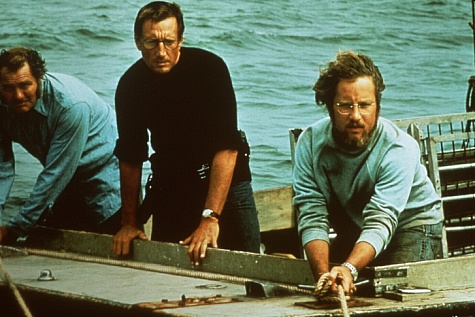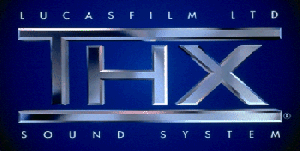
All Singing! All Talking! (All Dancing?)
Thatís the way the early sound films advertised themselves: "All Singing! All Talking! All Dancing!" Film had finally found its voice. But what was that about "All dancing"? You couldnít hear a dance, could you? Of course not (with the exception of a tap dance). But there is no point in dancing if you canít hear the music. In film, there is a vital connection between what you see and what you hear.
That early marketing phrase focuses our attention on the relationship between music and action. Think of the match between the rising of the monolith and the opening chords of Richard Straussís "Thus Spake Zarathustra" in 2001, or Johann Straussís "Vienna Waltz" and the orbit of the space station in the same film. (No, the space station is not revolving in 3/4-time, but we intuit a more cosmic waltz.)
 |
||
| When you hear those unmistakable low bass chords in Jaws, you know that Robert Shaw, Roy Scheider, and Richard Dreyfuss are in trouble. | ||
How about Wagnerís "Ride of the Valkyries" and the Huey helicopters in Apocalypse Now? Or John Williamsís low bass chords and the possible appearance of sharks in Jaws? Or the equally memorable John Williams phrase that serves as the chimes for Close Encounters of the Third Kind?
This is another way we prove the essential connection between film and music. If film did not exist, composers would have had to invent it (or something like it) to illustrate their compositions.
Itís no accident that Charles Chaplin, the greatest filmmaker of the silent period, was also a significant composer. Or that the Wurlitzer organ achieved commercial success because it quickly became a necessary component of the silent movie theater. The Rudolph Wurlitzer Company built more than 2,000 pipe organs for movie theaters during the silent period, and for good reason. Like all pipe organs, the Wurlitzers could accomplish simple sound effects (a door squeaking, tramping through the snow, explosions, and the like), so the organist at a Wurlitzer-equipped theater acted as an impromptu sound effects artist.
At larger theaters, where a pit orchestra accompanied the film, the percussionist served as the on-the-spot Foley artist. At smaller theaters where there was only piano accompaniment, you missed the extra effects. The theater in which you see a film does contribute, for better or worse, to your experience of the filmóeven today.
The point is that even the earliest filmmakers knew they needed music to make their "dancing" pictures truly entertaining. And since the incorporation of sound into film, directors have depended more than they would like to admit on composers to make their moving pictures come alive.
Movies without pictures would have been a very different mediumóbut not much less entertaining. Movies without any sound at all would be inconceivable (and likely not very profitable!) Weíll have more to say about this curious relationship in Lesson 7, "Off the Set."
A Sidetrack: Surround Sound
During the last 25 years, the technology of image projection has changed very little. The spread of multiplexes led to the development of the full-film platter. (If one projectionist has to handle six screens, he or she canít be around to change reels every 20 minutes!) But thatís about it. Of course, the screens are smaller, tooónot necessarily a plus.
 |
||
| Credit "bugs," such as this one for Lucas's THX certification, let you know that the sound quality meets certain standards. | ||
However, during this period, theatrical sound reproduction has undergone a revolution. In the beginning, it was enough to have a single speaker behind the screen. Then came stereo speakers in the front of the auditorium. Finally came the widespread use of surround sound tracks feeding speakers in the rear of the auditorium as well as the front. To go hand-in-hand with this development, the soundtrack was digitized, presumably providing greater fidelity. George Lucasís THX program (a set of technical standards for sound reproduction named after an early Lucas film) has done a lot to guarantee the quality of the sound in thousands of theaters, as well. Nowadays the credit "bugs," or logos, for numerous sound systems can fill a whole screen as the credits roll.
When the DVD-Video specification was being designed in the early 1990s, the current state of theatrical sound was taken into account. DVD-Videos can include as many as eight sound channels. You will see this feature referred to as 5.1 (pronounced "five dot one") or 7.1. In a 5.1 system, there are three front channels and two back channels (the "5") together with an "effects," or subwoofer, channel (the ".1") that is devoted to very low sounds. This effects channel is meant to produce a "feel" (such as an impending earthquake) rather than detailed audio information.
The huge growth of DVD-Video has fueled the demand for home theater installation. These need not be expensive; the main requirements, aside from the DVD player, are a receiver capable of driving five or more sound channels and the extra speakers to deliver the surround sound (you can certainly do without the effects channel, if you wish). While this configuration makes some sense for movies, where you might want the thrill of hearing the planes fly overhead from the front of your living room to the back, it doesnít add much to music. In fact, it can be misused by recording engineers―you donít want to sit in the middle of the band!
Use of 5.1 surround is useful to effects-heavy movies, but for music or "effects-light" movies like dramas and comedies, about all it can do is add a little ambience or room sound. The problem is that your living room is still probably quite a bit smaller than any movie theater you go to, so the "sweet spot," where the effects actually do what they are supposed to do and are properly balanced, is probably only one chair wide. Donít invite any friends over!
There are a number of other factors to consider when you are looking at a home theater audio system. There are a confusing number of digital encoding systems on the marketóDolby Pro Logic, DTS, Dolby Digital, and others (this is true in theaters, too)óbut most DVD players priced in excess of $50 will handle these sound standards.
If you want to know more about various competing sound standards, The Dictionary of New Media is a good guide. You can also find information online at http://readfilm.com.
Discussion
Please post your responses to the following topics on the class message board.